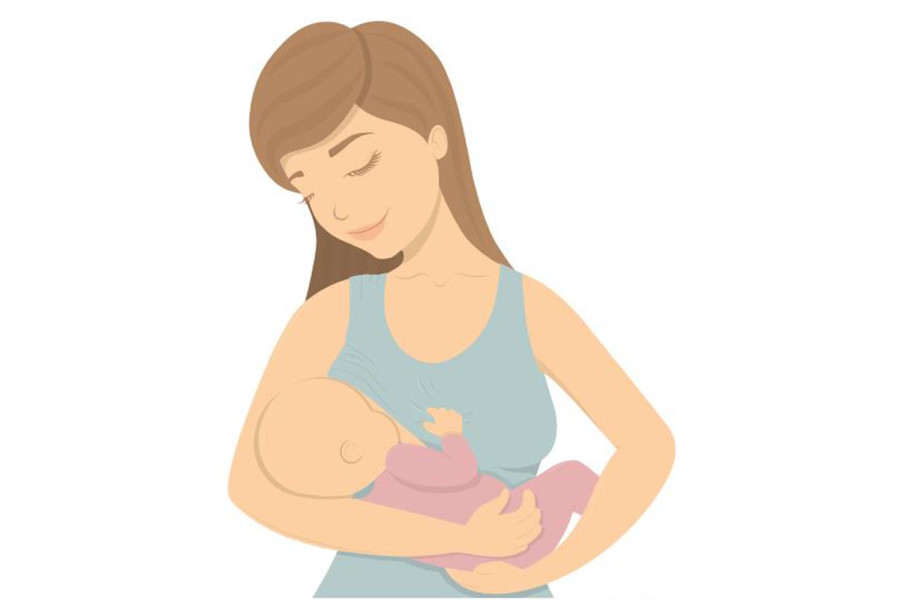Health
Educated, well-off mums wary of breastfeeding babies
Despite growing investment to promote practice, exclusive breastfeeding has been declining every year, report says.
Post Report
The Ministry of Health and Population spends more than Rs10 million to establish breastfeeding corners at government offices every year. It also conducts costly awareness drives on the importance of exclusive breastfeeding.
However, studies show that the exclusive breastfeeding rate in Nepal has been steadily declining over the years.
According to the Nepal Demographic and Health Survey-2022, exclusive breastfeeding has been continuously declining from 70 percent in 2011 to 56 percent last year.
The final report of the nationwide study carried out by the Ministry of Health and Population between January 5 and June 22 last year, with technical and financial support from the United States Agency for International Development, showed
that the exclusive breastfeeding rate has fallen from 66 percent in 2016 to 56 percent in 2022.
What concerns health officials is that more educated and well-off mothers are less likely to exclusively breastfeed their babies, as shown by the studies.
The proportion of children who are bottle-fed rises with increasing mothers’ education, from 12 percent among those whose mothers have no education to 49 percent among those whose mothers have more than a secondary education, the report said. Use of a bottle with a nipple is the highest in the highest wealth quintile—46 percent and lowest in the lowest quintile, 11 percent.
Exclusive breastfeeding is the highest in Sudurpaschim and Karnali provinces—74 percent each—and the lowest in Lumbini Province—36 percent.
The proportion of children aged 0–5 months who are exclusively breastfed fluctuates across wealth quintiles. The proportion is highest in the lowest wealth quintile—64 percent—and lowest in the highest quintile—44 percent.
The proportion of children who are bottle-fed is higher in urban areas, 26 percent, than in rural areas, 15 percent. Use of a bottle with a nipple is the lowest in Karnali Province at 11 percent and Madhesh Province at 12 percent and the highest in Bagmati Province at 43 percent.
“We thought that the educated, those from well-off families and residing in big cities would breastfeed their babies more than the uneducated and those from poor financial conditions and residing in remote villages,” said Lila Bikram Thapa, chief of the Nutrition Section at the Family Welfare Division of the Department of Health Services. “But the report suggests otherwise. Studies show that educated mothers and those from well-off families and residing in big cities need more awareness and education on the importance of breastfeeding.”
The report also showed that bottle-feeding practices started in health facilities. The report showed that 22 percent of children born in a health facility receive mixed milk feeding (breast milk and fresh, packaged, or powdered animal milk or infant formula), as compared with 12 percent of those born at home. Bottle feeding is not recommended, as the nipple on a feeding bottle is susceptible to contamination and increases the risk of diseases among children, according to the World Health Organisation.
The study also showed that children born of mothers with a secondary education more often receive mixed milk feeding than children of mothers with no education—(28 percent versus 9 percent).
Doctors say breastfeeding should continue for the first two years or beyond, as breast milk lowers children’s risk of illness, promotes their recovery during illness, and remains an important source of nutrients for healthy growth and development.
According to them, longer durations of breastfeeding have many health benefits for women, including reduced risks of certain breast and ovarian cancers and diabetes.
Nepal had committed to increasing the exclusive breastfeeding rate to more than 90 percent by 2030, but the rate declined from 70 percent in 2011 to 66 percent in 2016 and to 56 percent in 2022.
Nepal observes breastfeeding week starting August 1 every year as part of the global effort to promote the practice.




 13.12°C Kathmandu
13.12°C Kathmandu













